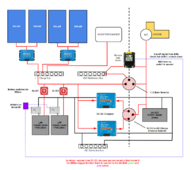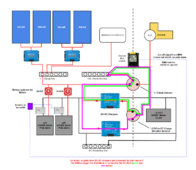I'm working on a system configuration for my small sailboat that involves a LFP based house bank, and a LA based start battery. The LA battery is always connected to the output of the alternator and is used to start the engine. The LFP bank is normally connected to the boat DC distribution bus, solar chargers, and AC inverter/charger.
The way I've designed the system (so far) is such that:
I can't seem to find a lot of info on whether this is acceptable or not, or if it would damage the chargers. Does anyone have any info, or better ideas?
Here's the layout as described above:

Here are the shorted paths, depending on switch position:

The way I've designed the system (so far) is such that:
- The LFP bank should receive sufficient solar energy to stay charged based on our needs and environment, most of the time
- The LFP bank CAN be, with a 1/2 switch, charged from the engine alternator via a DC-to-DC charger (normally this one is not selected)
- The LA bank CAN be, with the same 1/2 switch, charged from the LFP bank via a second DC-to-DC charger (normally this one is selected)
- The DC distribution bus can be powered by either the LFP bank or the LA bank by via a 1/2 switch (normally LFP)
- If the BMSes take the LFP batteries (2x) offline, for whatever reason, a signal triggers a remote battery switch to connect DC loads, with no interruption, to the LA bank -- this is primarily to avoid an issue like an autopilot disconnect, or other critical systems.
I can't seem to find a lot of info on whether this is acceptable or not, or if it would damage the chargers. Does anyone have any info, or better ideas?
Here's the layout as described above:

Here are the shorted paths, depending on switch position:



